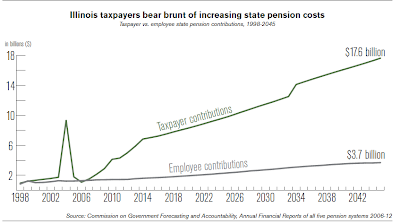Union Controlled Illinois Politicians Consider Tax Increases to Fund Pensions
Editor’s Note: This post by regular UnionWatch contributor Mike Shedlock documents the latest bad news for the Illinois Teachers Retirement System. And of course, union-controlled Illinois politicians have a solution: More taxes in one of the most overtaxed states in America. Like many if not most pension reformers, Shedlock advocates a scrapping of defined benefit plans, presumably in favor of defined contribution plans. But it doesn’t have to be that way. An adjustable defined benefit plan could work, eliminating the mortality risk and much of the market risk that make 401K plans undesirable for many individuals. To convert defined benefits to adjustable defined benefits, you would have to (1) use lower rate of return assumptions, (2) lower benefits across the board – to retirees, existing workers, and new employees – on a pro-rata basis, to levels that would restore solvency to the funds. Floors for workers in low-paying jobs with modest pensions could be established, along with ceilings for beneficiaries whose pensions are, say, more than twice the maximum social security benefit. If unions representing public sector workers would accept these tough reforms, they could keep their defined benefits.
In spite of a 12.8% annual return, with an 8% return assumption, the Illinois Teachers Retirement System (TRS) fell another $3.5 billion in the hole. TRS pension underfunding grew to $55.73 billion as of June 30, 2013.
Via email, the Illinois Policy Institute explains the growing liability.
First, TRS only has $0.40 in the bank for every dollar it should have today to make necessary pension payouts in the future. That means the high investment returns in 2013 were earned on less than half of the assets that TRS should have
TRS acknowledged this in a recent press release:
“Despite these strong returns, TRS cannot invest its way out of the funding hole we are in,” Ingram added. “This increase in the System’s unfunded liability, even with good investment results, is another wake-up call to state officials and our members that TRS long-term finances continue to head in the wrong direction.”
“Without changes to the pension code to ensure sustained and adequate funding, TRS faces the very real possibility that in a few decades the System will not have enough money to pay benefits to retirees. We cannot guarantee that TRS will have enough money to pay the pensions promised to every member in the System.”
Second, the inherent flaws of the state’s defined benefit pension system have driven up the shortfall significantly. According to the Commission on Government Forecasting and Accountability, the state’s pension shortfall grew by $41 billion from 1996 to 2012.
Of that amount, nearly $23 billion came from some form of missed “assumption” that continually plagues defined benefit pension plans:
- The investment returns for the state’s five pension funds were lower than their assumed 8% expectation. Cost to taxpayers: $9.5 billion.
- Unplanned benefit increases for employees. Cost to taxpayers: $1.1 billion.
- Changes in actuarial assumptions. Cost to taxpayers: $4.9 billion.
- “Other” actuarial factors. Cost to taxpayers: $7.2 billion.
TRS fails to acknowledge the failures of the defined benefits plan and instead chooses to blame taxpayers for not contributing enough to the system.
Who is to Blame for Shortfalls?
Please consider the Illinois Policy Center report State pension contributions: Taxpayers bear the brunt of increasing pension costs
A common refrain sounded by public sector unions is that government workers have consistently “paid their share” into Illinois’ pension systems and the state has not. However, the facts tell a different story.
While government worker contributions to Illinois’ five pension systems have increased by 75 percent since 1998, taxpayer contributions have increased by 427 percent over the same period. In 2012 alone, Illinois taxpayers contributed $3.5 billion more to the pension systems than state workers did.
Government workers’ share, as a percentage of total contributions, has continued to decline when compared to taxpayers’ contributions. In 1998, government workers paid for 47 percent of the state’s total pension contribution; today, they only pay 21 percent. By 2045, government workers will be expected to pay only 17 percent of total pension contributions.
Illinois’ Five Pension Systems
Illinois has five state pension systems, and all of them are seriously underfunded:
- The Teachers’ Retirement System, or TRS, manages pensions for teachers across Illinois (excluding Chicago).With more than 130,000 active members and nearly 95,000 retirees, TRS is the largest pension system in the state. Unfortunately, TRS also has the highest unfunded liability of the state’s pension systems. In 2012, TRS was only 40.6 percent funded and officially had more than $53.51 billion in unfunded liabilities. TRS members contribute 9.4 percent of their salary to the pension system.
- The State Employees’ Retirement System, or SERS, manages pensions for state-level employees across Illinois. It has 62,000 active members and 50,000 retirees. In 2012, SERS was only 33.1 percent funded and had officially $22.13 billion in unfunded liabilities. Under its regular pension formula, SERS members covered by Social Security contribute 4 percent of their salary, and those not covered by Social Security contribute 8 percent of their salary to the pension system.
- The State Universities Retirement System, or SURS, manages pensions for employees working at state universities. It has 71,000 active members and more than 45,500 retirees. In 2012, SURS was only 41.3 percent funded and had officially $19.46 billion in unfunded liabilities. SURS members contribute 8 percent of their salary to the pension system.
- The Judges’ Retirement System, or JRS, manages pensions for judges throughout the state. It is one of the two smaller pension systems, with only 968 active members and 725 retirees. Despite its small size, in 2012 JRS was only 28.6 percent funded and officially had $1.44 billion in unfunded liabilities. JRS members contribute 11 percent of their salary to the pension system.
- The General Assembly Retirement System, or GARS, manages pensions for members of the Illinois General Assembly. Despite having only 176 active members and 294 retirees, GARS has the dubious honor of being the worst-funded pension system in the state. In 2012, GARS was only 17.4 percent funded and officially had $251 million in unfunded liabilities. GARS members contribute 11.5 percent of their salary to the pension system.
All Five Systems Bankrupt
TRS, SERS,SURS, JRS, and GARS are all insolvent. None of them can possibly meet their pension obligations. With 10-year treasuries yielding a scant 2.5%, plan assumptions of 8% are preposterously high on a sustained basis.
Yet, TRS went another $3.5 billion in the hole in spite of a 12.8% annual return.
What the hell is TRS going to do in the face of a stock market plunge, a bond market plunge, or both?
GARS, the General Assembly Retirement System is only 17.4% funded. Is it any wonder that state legislators are pressing for more tax hikes?
Beware Tax Hikes!
On October 18, I reported Illinoisans Beware: “Progressives” Seek Massive Tax Hike Again; Fight the Hike!
Pension shortfalls are the reason for the proposed hikes.
A few people commented the “progressive” tax was not as much as they pay. Here is Rep Naomi Jakobsson’s proposed scheme.
What I failed to point out previously is that I pay $14,000 annually in property taxes on a home I can sell for $400K or so.
Sales Taxes
My sales tax rate is 7.75%. But hey, that could be worse. Cicero tops the state with a 9.5% tax. In Chicago, the sales tax is 9.25%.
In spite of all these massive taxes, the entire state is bankrupt!
The Solution
Raising taxes for the benefit of legislators and seriously undeserving public unions is certainly not the answer. The solution is twofold:
- Immediately kill all Illinois public defined-benefit pension plans
- Drastically lower existing pension plan expectations, via default if necessary
Nothing else can possibly work, and the numbers prove it.
About the Author: Mike Shedlock is the editor of the top-rated global economics blog Mish’s Global Economic Trend Analysis, offering insightful commentary every day of the week. He is also a contributing “professor” on Minyanville, a community site focused on economic and financial education. Every Thursday he does a podcast on HoweStreet and on an ad hoc basis he contributes to many other websites, including UnionWatch.


